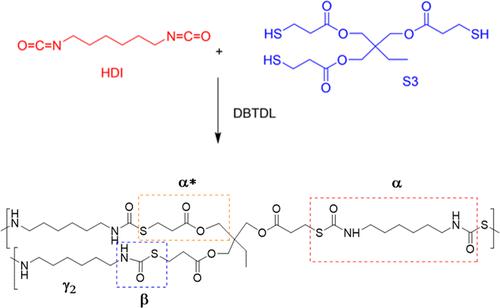当前位置:
X-MOL 学术
›
ACS Appl. Polym. Mater.
›
论文详情
Our official English website, www.x-mol.net, welcomes your
feedback! (Note: you will need to create a separate account there.)
Analysis of Poly(thiourethane) Covalent Adaptable Network through Broadband Dielectric Spectroscopy
ACS Applied Polymer Materials ( IF 4.4 ) Pub Date : 2023-01-06 , DOI: 10.1021/acsapm.2c01543
B Pascual-Jose 1 , S De la Flor 2 , A Serra 3 , A Ribes-Greus 1
ACS Applied Polymer Materials ( IF 4.4 ) Pub Date : 2023-01-06 , DOI: 10.1021/acsapm.2c01543
B Pascual-Jose 1 , S De la Flor 2 , A Serra 3 , A Ribes-Greus 1
Affiliation

|
The dielectric spectra of the poly(thiourethane) network, HDI-S3, have been analyzed to know the nature and the cooperativity of each of the six dielectric processes observed. At low temperatures, γ1, γ2, and β dielectric relaxations were attributed to noncooperative local motions in the glassy state, in which apparent activation energies are 30, 36, and 60 kJ·mol–1, respectively. At higher temperatures, three dielectric relaxations are observed (αTg, α*, ρ). The αTg relaxation is attributed to the glass transition, and it is overlapped with the α* relaxation. The molecular origin of α* relaxation is associated with the bond exchange reaction. Finally, the ρ relaxation is ascribed to the heterogeneity of the sample although its origin is uncertain. The DC conductivity (σDC) is found to be an appropriate variable to analyze the bond exchange reaction. Accordingly, the HDI-S3 has a molecular exchange mechanism of dissociative nature.
中文翻译:

通过宽带介电光谱分析聚(硫代氨基甲酸酯)共价适应性网络
分析了聚(硫代氨基甲酸酯)网络 HDI-S3 的介电光谱,以了解所观察到的六个介电过程中每一个的性质和协同性。在低温下,γ 1、γ 2和β 介电弛豫归因于玻璃态中的非合作局部运动,其中表观活化能分别为30、36 和60 kJ·mol –1。在较高温度下,观察到三种介电弛豫 (α Tg、α*、ρ)。αTg _弛豫归因于玻璃化转变,它与 α* 弛豫重叠。α* 弛豫的分子起源与键交换反应有关。最后,尽管其来源不确定,但 ρ 松弛归因于样本的异质性。发现直流电导率 (σ DC ) 是分析键交换反应的合适变量。因此,HDI-S3 具有游离性质的分子交换机制。
更新日期:2023-01-06
中文翻译:

通过宽带介电光谱分析聚(硫代氨基甲酸酯)共价适应性网络
分析了聚(硫代氨基甲酸酯)网络 HDI-S3 的介电光谱,以了解所观察到的六个介电过程中每一个的性质和协同性。在低温下,γ 1、γ 2和β 介电弛豫归因于玻璃态中的非合作局部运动,其中表观活化能分别为30、36 和60 kJ·mol –1。在较高温度下,观察到三种介电弛豫 (α Tg、α*、ρ)。αTg _弛豫归因于玻璃化转变,它与 α* 弛豫重叠。α* 弛豫的分子起源与键交换反应有关。最后,尽管其来源不确定,但 ρ 松弛归因于样本的异质性。发现直流电导率 (σ DC ) 是分析键交换反应的合适变量。因此,HDI-S3 具有游离性质的分子交换机制。

































 京公网安备 11010802027423号
京公网安备 11010802027423号